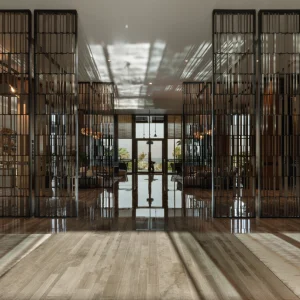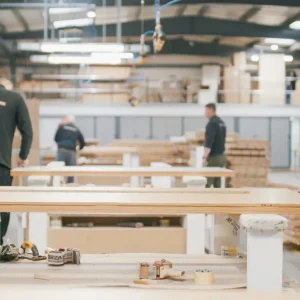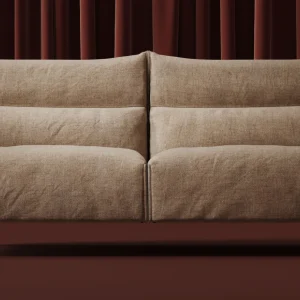
Last November the Design Museum announced its 2014 programme, which included a major exhibition from Daniel Weil. Time Machines: Daniel Weil and the Art of Design is now only a few weeks away from opening, but several months before that I was able to meet up with Daniel Weil at Pentagram’s London office. Described as ‘witty and thought provoking’ the exhibition will feature a series of ‘especially created pieces’, as well as Weil’s sketchbooks and objects from his personal archive spanning his career to date of 30 and more years.
Guest curating the exhibition is Martina Margett, senior tutor in critical and historical studies at the RCA, who describes Weil as a ‘one-man Bauhaus’ when addressed with the complex task of organising Weil’s numerous product, packaging and interior design projects for the eagerly anticipated show – all of which I was keen to talk about with him.
But having only met Weil once before, and that briefly during the show’s press launch in November to request an interview – it soon became clear that I had underestimated him. I soon leaned that expecting a formulaic, predictable response was never going to happen with Weil, dependably talking in context of his design philosophy, ensuring all his answers going way beyond the scope of my questions. It certainly was a witty and thought-provoking conversation.
‘For me, designing is more important than the design, because it remains the receptacle of the continuum that contains all the knowledge – not the object,’ Weil tells me. ‘Yes, I want it [the exhibition] to be a show that focuses on objects, but each object contains specific knowledge. The object is no more than an empty vessel and for me it’s trying to understand what filled that vessel and what made it; that is more interesting as a designer or as a creative person.’
As well as showcasing some of Weil’s better- known works, such as his Radio in a Bag (1982)and other commissioned pieces by various clients including Swatch, it is Weil’s ambition to promote the ideas of a ‘designing’ education through the show, using his other lesser-known, or abstract, ‘vessels’ that will also be on display.
Weil, a former professor of industrial design at the Royal College of Art, says designers are duty bound to teach the new generation of designers ‘designing’ methods and techniques as a way of ensuring cultural impact. ‘Art history used to be about only looking back, for example the impact of the 17th century had on the 21st century,’ he says. ‘Now, we look back and forward at the same time and I try to do the same. My hope is to talk about design: the next generation, which sounds a bit Star Trekky!’

Weil’s sketch for his latest clock, which will be unvieled and displayed at the exhibition of his work at the Design Museum. PhotoCredit:Daniel Weil
Describing his own design training as a ‘fourth-generation modernist education’ Weil regards himself as a new-technology witness and recalls key changing moments: ‘I remember the Texas Instruments calculator we were not allowed to use our university exams! That was the only item of new technology that was available at the time. But I feel lucky that I can trace why things have happened and I think designers need to do that too, because you never know when the batteries will be removed and the light will be turned off.’
Looking forward at a new generation of designers, Weil does so while expressing a sort of love/hate relationship with technology. His promotion of the idea of ‘living in the age of the speed of light’ raises the concern that designers are losing a ‘humanist dimension’ in design, by relying too heavily on computer programs to communicate quickly. Weil fears that future generations of designers will lose key skills, such as sketching and even creativity, through an information-technology alliance.
‘You cannot go through life with a populist ignorance, where information becomes culture,’ he says.
‘Information is not culture; the fact that you can find it and read about it doesn’t mean that you have connected to something. You’re only going to discover and connect to those things by being there, or by finding a book. And I love serendipity, I love the accidents and love the mistakes – I love all those things! And they have been part of my process.’
Weil studied at the RCA in 1978 and describes the time of his arrival in the UK from Argentina as one of ‘serious aesthetical austerity’. Leading a modest life he would often collect material and objects from skips, but adds that the UK’s turbulent politics of the time shaped him significantly. ‘It was not postwar, but somehow there was a sense of postsocialism that had arrived in 1978 in the few months before Margaret Thatcher became prime minister. I found myself, like most openminded and socially inspired people, in absolute opposition to everything that was happening and its brutal, transformative parts.’
Yet despite feeling oppression, Weil says London offered him an invaluable creative freedom. After graduating from the RCA in 1981 he started to design and manufacture his first collection for the Memphis Group in 1982, which was influenced by a more ‘constrained’ Milanese style. ‘The amazing thing in the Eighties was the things that I was doing; they were very colourful and that was influenced by going to Milan,’ he says.

Radio in a Bag (1981). PhotoCredit:Daniel Weil
‘But Milan and London had nothing in common and I remember saying that there was nothing in London, apart from it providing me with total freedom. In Milan designers were captive to a specific "freedom" that was provided by the Italian medium, which at the time was colour. So the notion of being in some sort of Milanese world was very constraining, whereas London was totally liberating and I could have one aesthetic enjoyment one day then a totally different one the next.’
The days of salvaging from skips are over for Weil, though he emphasises how important his object-collecting antics were during the Eighties, and that he still has the items. And he is quick to correct me: ‘I keep. I don’t collect. And I keep sometimes selectively, sometimes not. But I’m not a hoarder! Some of these things will be in the show – in fact a lot of these things will be in the show’.
Weil’s objects, which are often small and even what he says are ‘ridiculous’, are his way of remembering something and ‘keeping’ a moment of time. They held a particular significance to his design practice throughout the Eighties and says ‘I would recognise objects as if they could be connected together, even if they had nothing to do with each other or did not fit dimensionally. They sort of became other objects. I used to seriously believe that the most important thing, in the early Eighties, was creating objects that subverted the sense of value. If anything, I was just doing myself out of earning any money, because things shouldn’t look valuable!’
Sitting in the large meeting room at the Pentagram office I am drawn to Weil’s numerous and well-known clocks that sit ticking around the room. They too are expected to be on display in the exhibition, along with a new addition, offering another dimension to his kept objects. Each clock has been designed by Weil to represent ‘present’ design, and have been made at various stages in his career. ‘An important thing for me to state is that I always design for the present’, he says. ‘A product belongs to the present and this present could last 10 years, 20 years or hopefully more.’
I suspect the clocks, along with Weil’s other objects, hold much more value and understanding to Weil. I can only see them as desirable objects, yet the irony is not lost on me, which perhaps is testament to his post-modern design exposure.
Nevertheless, each clock pays homage to time and the sentiment of looking back to the then present; and being able to map your design journey from that point is something Weil regards with importance. ‘It’s wonderful to be able to put the next layer on that cultural journey, but make it a better one. Some previous journeys were no more than marketing devices. Delivering conveniences, but delivering other inconveniences.’
We walk upstairs to Pentagram’s’main open-plan office area and head over towards Weil’s workspace. He shows me the prototype for his latest clock, which will also be feature in the show. The space is quite typical to an architect’s office, with piles of paper, filing cabinets and drawing boards, and it doesn’t surprise me that Weil doesn’t appear to have his own office, given the ‘flat’ approach of the company to running the business.

Another of Weil’s clocks, the Architect Clock. It is part of his most recent A Matter of Time collection. PhotoCredit:Daniel Weil
Weil joined Pentagram in 1992, is still there after 22 years and is now a partner. Many designers would have surely left to set up design studios of their own a long time ago, but I wonder if Weil’s socialist influences are what have helped him to stay put? ‘I own Pentagram. If you ask any of the partners they will also say "I own Pentagram", says Weil. ‘It’s the sense of ownership that is unique and the sense of community; it is the glue that keeps people together, but we all shape our experiences and our team. It’s very personal and it remains personal and that’s why we are the best at helping organisations change because we don’t have any corporate hang-ups ourselves, but they will have!’
But as if he could read my mind he is quick to add: ‘We are not anti-corporate or countercorporate. We are just not corporate. Our structure doesn’t lend itself to that – the individuality and the generosity doesn’t lend itself to being corporate. I don’t know how long we can keep it like that, but it doesn’t look like it’s going to change.’
I then ask if he has any plans to retire. Was the exhibition somehow marking ‘the end’? (He was born in Buenos Aires in 1953). Weil laughs, and as expected I get a ‘no’ for an answer. After spending the morning talking with him, it’s hard to picture Weil retiring from design. Perhaps a time will come when he will cease using design as a form of earning, but I’m sure he’ll always be working on something – no doubt expanding on the clock series and adding a few more layers on to his design and technology journey.
Interestingly I read a fact about the Texas Instruments calculator as having more processing power than the guidance computer from the Apollo 11 space mission to the moon, so I’m sure stories like this will continue to amuse him when joining the dots together.
Weil accompanies me to the door and we discuss what items of design, or other, would we take with us to a dessert island. ‘I’m actually not a consumer of design. It’s, again, probably part of my experience,’ he says. As we walk out via the courtyard he ponders on the question and says: ‘I like going to the beach to make sand drawings where I use glue to stick various sand surfaces. So that is what I’d take, glue.’
Time Machines: Daniel Weil and the Art of Design opens at the Design Museum, London, 14 May – 31 August. designmuseum.org





